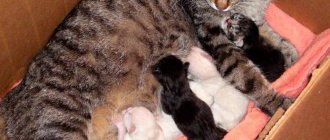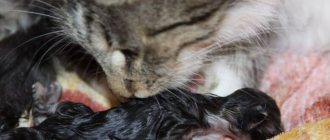When you need help
Is it possible to induce labor in a cat on your own? In some cases, it is not only possible, but also necessary. As a rule, pregnancy in cats lasts 55-60 days. A slight delay in the birth of kittens is normal, but if the animal does not give birth 68-70 days after mating, measures must be taken. The babies grow in the mother's womb, becoming larger and larger, and the larger the kittens, the more complications the birth will be.
© shutterstock
Second stage of labor
At this stage, the abdominal muscles and diaphragm begin to move - strong attempts begin. The first kitten is moving towards a new life. The amniotic sac ruptures and some amniotic fluid leaks out of the cat's vagina. The cat at this moment lies on its side, in some cases stands or sits. Kittens, like humans, are born head first, although breech presentation is the norm.
After the kitten is born, the cat licks it, frees it from the amniotic sac, gnaws the umbilical cord and puts it to the chest.
Medicines
You can induce labor in a cat at home using certain medical products.:
- Oxytocin . It causes contractions of the uterus and helps speed up the labor process. This synthesized hormone can only be used after consultation with a veterinarian.
- Travmatin . Relieves pain and helps regulate contractions, helps avoid complications and injuries while the animal is giving birth, promotes healing and prevents inflammation.
- Gamavit . Stimulates the uterine muscles, facilitates childbirth in difficult cases.
- Calcium gluconate . Not only stimulates labor, but also helps milk production.
In order not to harm your cat, you should carefully read the instructions for the medications and be sure to consult a veterinarian.
How to deliver a cat: complications of childbirth in cats
1) Uterine atony (weak contractions or cessation of contractions)
How to deliver a cat with uterine atony:
Inject oxytocin intramuscularly (into the thigh of the hind paw), it is better to give 2-3 injections (no more than 0.5 ml in total) with an interval of 30-45 minutes.
ATTENTION!! You can inject oxytocin only after the birth of the first kitten. An overdose of oxytocin can lead to uterine rupture. Do not use it unless necessary. Before using the drug, consult your veterinarian!
How to deliver a cat if the kitten is stuck in the birth canal:
Put on gloves and sterilize them. Lubricate the gloves with Vaseline and, when during contractions some part of the kitten appears in the vulva, pull the vulva down at the anus, so the kitten will be held tightly and will not slip out. Then, in time with the contractions, begin to pull the kitten towards you, rocking it a little from side to side. You can only pull the kitten by the skin on the back or neck (the withers), trying not to rupture the amniotic sac, if it has not ruptured before.
We suggest you read: How to protect walls from a cat?
How to deliver a cat if the kitten was born in the amniotic sac:
The bladder must be opened with sterile scissors within 30 seconds after the kitten is born. Free the kitten's mouth and nose from amniotic fluid using an enema, pipette or syringe without a needle. Dry the kitten vigorously with a towel or flannel cloth, or let the cat lick it.
ATTENTION!! The umbilical cord can only be cut when the kitten is freed from the amniotic sac and amniotic fluid. Otherwise, the kitten will drink too much water and most likely die.
How to deliver a cat if the cat has not chewed the umbilical cord:
How to deliver a cat if the cat did not lick the kitten:
Dry the kitten vigorously with a towel, massaging its body and especially the anus - it is necessary to induce urination and defecation. After the procedure, place the kitten with its mother.
How to deliver a cat if the kitten shows no signs of life:
Clear the kitten's mouth and nose of amniotic fluid using an enema, pipette, or syringe without a needle. Dry the kitten thoroughly with a towel and massage it. Let the kitten sniff ammonia on a cotton swab; if a reaction occurs, continue resuscitation. If there is no reaction, the kitten has died.
Gently squeeze the kitten's chest, first from the sides and then from front to back. If this does not help, give the kitten mouth-to-mouth artificial respiration. Do not use force; inhale air only until the kitten’s chest expands. You help the kitten inhale, and the exhalation should be passive. Continue until the kitten breathes on its own.
To restore heart rate, you need to squeeze the kitten's chest once per second.
How to act
If there is a need to induce contractions in a cat, you need to use Oxytocin. This drug will help strengthen the tone of the muscle tissue of the uterus before labor begins. The medicine is administered intramuscularly or subcutaneously; its effect begins within 2-3 minutes after the injection. It is very important to follow the dosage, otherwise complications may arise, including the death of the kittens.
How much drug should I use? For cats, the following dosage should be used: 0.2-0.3 ml for intramuscular or subcutaneous injection, the injection is given between two contractions. If there is no result within 1/3 hour, the drug is re-administered at the same dose. The maximum number of injections is 3; if there is no effect, you cannot increase the dosage - this will lead to negative consequences.
How to give an injection? To help your pet give birth to offspring, you should inject the drug into the withers. To do this, the animal’s skin is grabbed with one hand and an injection is made into the hollow formed at the back. It is important to puncture the skin and inject the drug between the skin and muscles.
© shutterstock
The intramuscular injection is easy. The optimal place for the injection is the thigh, the paw is held with one hand, and the syringe needle is inserted at an angle with the other hand. After the procedure, the injection site should be gently massaged, this will help the drug dissolve faster. Similar injections are given if the cat carries the pregnancy to term.
It is extremely important to wash your hands thoroughly before injection and use only sterile instruments. The same needle cannot be used twice.
Complications during childbirth
It happens that the normal course of labor may be interrupted by certain complications. The owner needs to be very careful, especially if the cat is giving birth for the first time.
How to help a cat during childbirth and what can cause complications?
What to do if a cat develops a bladder during childbirth
Most often, the amniotic sac ruptures while still inside the woman in labor. If the entire bubble comes out, you can help the cat break it by first disinfecting your hands.
What to do if the kitten is born too big
You need to wait for the kitten to partially emerge during the contraction, then carefully use your index finger, pre-lubricated with Vaseline oil, to move the skin from inside the cat’s vagina closer to the anus. And then you need to carefully grab the kitten and move it from side to side with gentle movements, thus helping it to be born.
What to do if a cat gives birth to dead kittens
If a cat cannot give birth to dead kittens, she definitely needs help. The only difference is that the kitten can be pulled by any part of the body, just to free the woman in labor from the dead fetus, so that severe inflammation with subsequent infection does not occur.
Gamavit for obstetrics
This traditional medicine is recommended to be used to help cats during childbirth for several reasons.:
- It helps to avoid uterine rupture due to excessively large offspring;
- It prevents diseases such as endometritis and pyometra.
- Reduces the risk of birth and postpartum complications.
- Allows the animal to quickly return to normal after birth.
The product is used by injection - intravenous, subcutaneous and intramuscular. To speed up the absorption of the medicine into the blood and induce labor, the injection should be given under the shoulder blade. In agreement with the veterinarian, the drug can be given to the cat to drink. For an adult cat, the dosage of the drug for one injection can be from 1 to 1.5 ml.
© shutterstock
Normal and abnormal course of labor
Prevention of all possible complications during childbirth begins with caring for a pregnant cat . As soon as you discover that your pet is pregnant, regardless of whether mating was planned, she must be shown to a veterinarian.
A cat's pregnancy can be determined from 2–3 weeks using a blood test. At 3–4 weeks, the expectant mother's mammary glands swell. As the gestation period increases, the following signs are observed:
- Increased hunger.
- Redness of the nipples.
- Toxicosis.
- Slight but constant weight gain.
- Behavioral changes - frequent meowing, restlessness, unusual affection or irritability.
During the normal course of pregnancy, by about 5–6 weeks, the pet’s belly becomes noticeably rounded. If gestation proceeds without complications, the cat receives decent care, has no genetic defects, and birth occurs from 64 to 71 days of pregnancy.
Important! During the normal course of pregnancy, before the onset of contractions, the cat should not experience any discharge from the genitals. The only exception is early rejection of the mucus plug, which can occur several weeks before birth.
It will be easier for an inexperienced owner to cope with the situation if the nest for birth is prepared in advance. It is necessary to monitor the cat’s behavior; most often, she herself chooses a suitable (from her point of view) place. You can take the initiative and equip a nest for your cat from a spacious box. In order for the expectant mother to feel safe, the box must be closed (have a roof).
During the first contractions, you may find that the cat is restless, constantly entering the nest, or looking for a suitable place to give birth to kittens. The pet can meow loudly and attract the attention of the owner, especially if she is about to give birth for the first time. The first contractions bring discomfort, but the cat successfully hides the pain. The owner may not notice the discharge of amniotic fluid and the rejection of the mucous plug, since the cat licks the genital area.
As the labor process progresses, contractions will intensify and the interval between them will decrease. When the interval is reduced to 20–30 seconds, the cat will lie down on its side and prepare to push.
The first kitten takes longer to be born than all the others; to expel it, the cat will need to make 3-4 strong attempts. The total duration of the process from the start of contractions to the appearance of the first kitten can take from 2 to 24 hours. Normally, contractions last up to 12 hours, and pushing at the birth of the first kitten lasts up to 1 hour.
Note! After the birth of the first kitten, the remaining babies should appear at intervals of 10–20 minutes.
As soon as the baby is born, the cat licks its face, gnaws the umbilical cord and eats the afterbirth. If the woman in labor does not pay attention to the kitten, and the expulsion occurs too quickly, the pet may be in rapid labor. This complication is associated with severe pain, so it is advisable to immediately remove the kittens from the nest, remove fluid from the respiratory tract, rub them and place them on a heating pad.
How to help a cat give birth at home
Pregnancy in a domestic cat is relatively quick, lasting 55 to 60 days. Some individuals give birth completely independently and human participation in this process is not important to them. British cats, Sphynxes, Maine Coons or Persians require the obligatory assistance of the owner during childbirth or even the presence of a veterinary obstetrician.
It is advisable to know exactly how much time has passed since the moment the animal was mated, in order to be prepared for the required time.
The approach of “day x” will be indicated by the so-called harbingers of childbirth, during which the expectant mother is a cat:
- begins to look for a secluded place to build a nest;
- becomes very affectionate with a person, requires special attention to himself;
- may refuse to eat;
- begins to lick the swollen mammary glands.
A few days before the expected birth, you need to prepare the necessary list of things that may be needed to help the cat and her cubs:
- Childbirth box. Place in a secluded, warm place;
- Disposable diapers and sterile wipes;
- Disposable syringes and medications if there is a possibility of complications;
- Vaseline oil;
- Sharp scissors;
- Disinfectant solution;
- Surgical or silk thread to tie the umbilical cord;
- Iodine or brilliant green.
Help with prolonged labor
Make it a rule not to interfere with the birth process until you are sure that the woman in labor needs help. Stimulation of the birth process and other interventions can harm not only the kittens, but also the pet.
Be sure to contact your veterinarian if you notice the following complications:
- Black, green, bloody, or foul-smelling discharge during labor.
- Labor lasts longer than 36 hours.
- Contractions last more than 12 hours.
- Pushing that lasts longer than 30–60 minutes and does not produce a kitten.
- An amniotic sac has appeared in the birth canal, but the horse cannot push it out for more than 10 minutes.
With such complications, self-help is not only useless, but also dangerous. If you cannot call a veterinarian at home, ask for instructions over the phone. Listen carefully to how to induce labor in a cat, write down the names of the medications and pay special attention to the dosage.
To stimulate labor or pushing, the well-known drug Oxytocin . The average dosage is 0.3 ml once an hour, for a cat weighing 4–5 kg. Oxytocin is not recommended to be administered more than three or four times, since excessive stimulation can lead to weakening of the body, damage to the birth canal and bleeding.
Note! Oxytocin is used for several purposes: to speed up labor, resume contractions or pushing, enhance or initiate lactation.
If difficulties in childbirth occur due to the fact that a dead kitten is stuck in the tract, after its expulsion it is necessary to carry out resuscitation measures. Open the amniotic sac and remove amniotic fluid from the respiratory tract using a syringe without a needle. Actively rub the kitten with a dry towel; if it does not begin to breathe or move, place it on a heating pad and continue rubbing the body from the limbs to the sternum.
Note! If the kitten's skin turns pink when rubbed and warmed, it means there is blood flow and you still have a chance to revive the baby.
When you contact your veterinarian, you will most likely be given several options:
- Use of Oxytocin.
- C-section.
Recently, the reputation of Oxytocin has deteriorated greatly; experienced owners prefer to use it only in extreme cases. Despite the reviews, Oxytocin was and remains the only, unique drug that can effectively stimulate labor. Veterinarians say Oxytocin is not dangerous if administered in the correct dosage and under medical supervision.
Note! If induction of labor in a cat occurs in a clinical setting, Oxytocin is administered intravenously and gradually (drip).
C-section
Surgery is considered the most reliable solution in case of protracted labor. Experienced cat owners sign up expectant mothers for a planned caesarean section as soon as they learn they are pregnant. It is never too late to refuse surgery, but if complications arise, the owner will be confident that his pet will be taken care of.
A caesarean section is an abdominal operation in which the walls of the peritoneum and uterus are cut. Kittens are removed from the uterus along with amniotic sacs and placenta. Typically, several doctors are involved in the operation or the veterinarian is assisted by a paramedic who performs resuscitation measures while the doctor stitches up the cat.
If your pet is outbred, the pregnancy was not planned or was accompanied by severe complications, during a caesarean section, the doctor can remove the uterus and ovaries - castration. Before abandoning the proposed alternative, keep in mind that a cat who has had a cesarean section (most likely) will no longer be able to give birth on her own.
After a cesarean section, the kittens should be bottle-fed for 24 hours, since there will be drug residues in the mother’s blood. If the uterus and ovaries were preserved during the operation, wait several days for the cat to begin lactation. If lactation does not begin, drug therapy is used.
Note! When performing a cesarean section followed by castration, the chance of lactation occurring is significantly reduced (although not excluded). Before the operation, the veterinarian will warn you that the kittens will have to be artificially fed.










